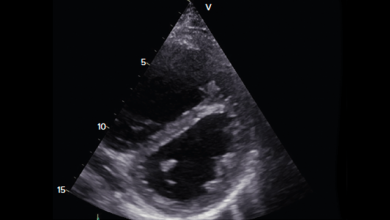Search results
Author(s):
Malcolm M Bersohn
Added:
3 years ago
Permanent pacemakers have been used to treat patients with symptomatic bradycardia for 45 years. The earliest pacemakers paced only the ventricle and were used primarily for patients with complete heart block. The need for atrial pacing became apparent as pacing for sinus node dysfunction became more common. Initially, only single-chamber pacing was possible in the atrium, and this was a good…
View more
Author(s):
Malcolm M Bersohn
Added:
3 years ago
Permanent pacemakers have been used to treat patients with symptomatic bradycardia for 45 years. The earliest pacemakers paced only the ventricle and were used primarily for patients with complete heart block. The need for atrial pacing became apparent as pacing for sinus node dysfunction became more common. Initially, only single-chamber pacing was possible in the atrium, and this was a good…
View more
Author(s):
Angelos Tsipis
,
Evdokia Petropoulou
Added:
2 years ago
ESC 23: The RIGHT Study
Author(s):
Yan Yan
,
Gilles Montalescot
Added:
7 months ago
Video
Author(s):
Mark Huffman
,
Vallerie V McLaughlin
Added:
3 years ago
Idiopathic pulmonary arterial hypertension (formerly referred to as primary pulmonary hypertension) is an uncommon yet progressively fatal disease defined by the presence of mean pulmonary artery pressure greater than 25mmHg at rest or greater than 30mmHg with exercise as tested by right heart catheterization in the absence of other etiologies for pulmonary hypertension. Across several studied…
View more
Author(s):
Stuart J Beldner
,
Francis E Marchlinski
Added:
3 years ago
Accessory pathways are formed embryologically during cardiogenesis and may be broad, slanted, and occasionally particularly challenging to ablate. Right-and left-sided pathways are derived differently with right-sided pathways characteristically subendocardial as opposed to subepicardial. Successful ablation of right-sided pathways is frequently limited by catheter stability and ablation attempts…
View more
Author(s):
Mark Huffman
,
Vallerie V McLaughlin
Added:
3 years ago
Idiopathic pulmonary arterial hypertension (formerly referred to as primary pulmonary hypertension) is an uncommon yet progressively fatal disease defined by the presence of mean pulmonary artery pressure greater than 25mmHg at rest or greater than 30mmHg with exercise as tested by right heart catheterization in the absence of other etiologies for pulmonary hypertension. Across several studied…
View more
Author(s):
Mark Huffman
,
Vallerie V McLaughlin
Added:
3 years ago
Idiopathic pulmonary arterial hypertension (formerly referred to as primary pulmonary hypertension) is an uncommon yet progressively fatal disease defined by the presence of mean pulmonary artery pressure greater than 25mmHg at rest or greater than 30mmHg with exercise as tested by right heart catheterization in the absence of other etiologies for pulmonary hypertension. Across several studied…
View more
Author(s):
Mark Huffman
,
Vallerie V McLaughlin
Added:
3 years ago
Idiopathic pulmonary arterial hypertension (formerly referred to as primary pulmonary hypertension) is an uncommon yet progressively fatal disease defined by the presence of mean pulmonary artery pressure greater than 25mmHg at rest or greater than 30mmHg with exercise as tested by right heart catheterization in the absence of other etiologies for pulmonary hypertension. Across several studied…
View more
Author(s):
Malcolm M Bersohn
Added:
3 years ago
The usual reason for pacing is to prevent bradycardia, which is most commonly due to sick sinus syndrome or atrioventricular (AV) nodal disease. The need for pacing for either of these indications increases progressively with age. Atrial fibrillation (AF) is the most common serious arrhythmia. The incidence of AF also increases progressively with age, and patients with pacemakers may be even more…
View more











